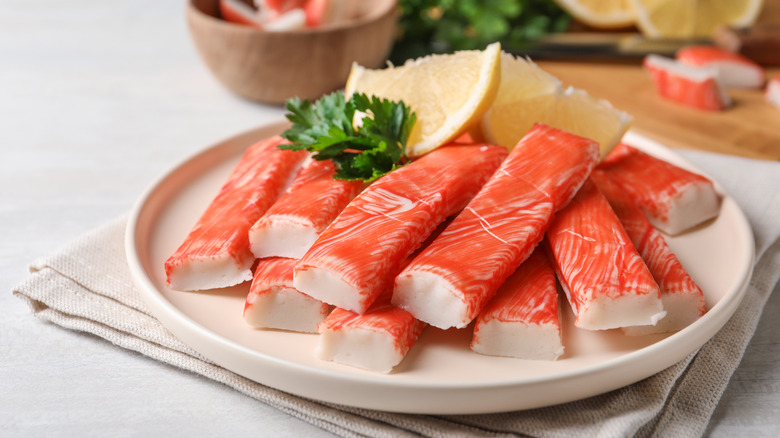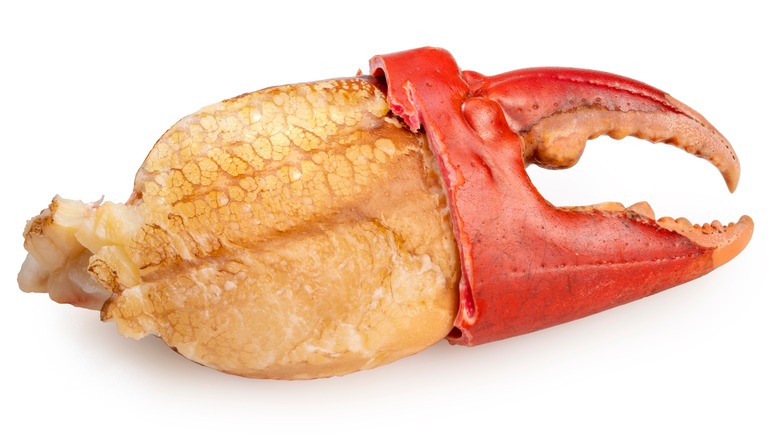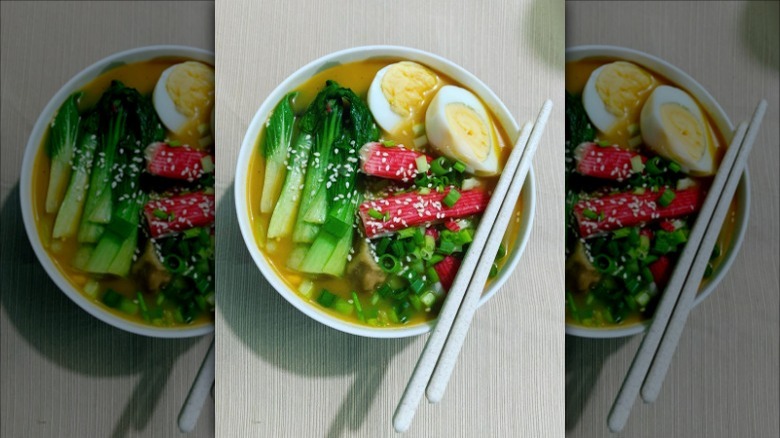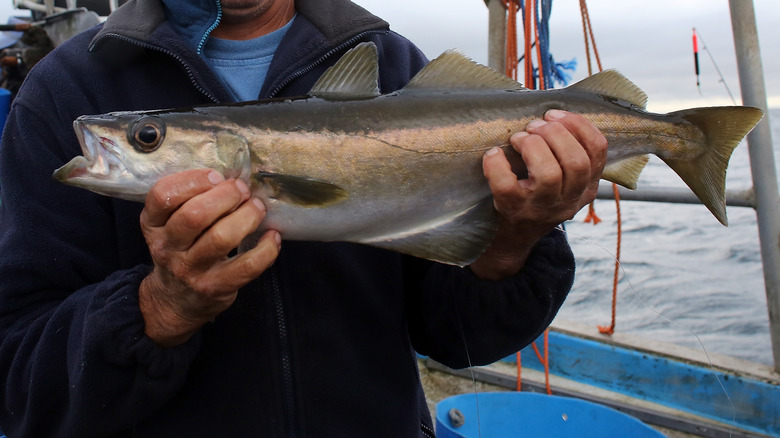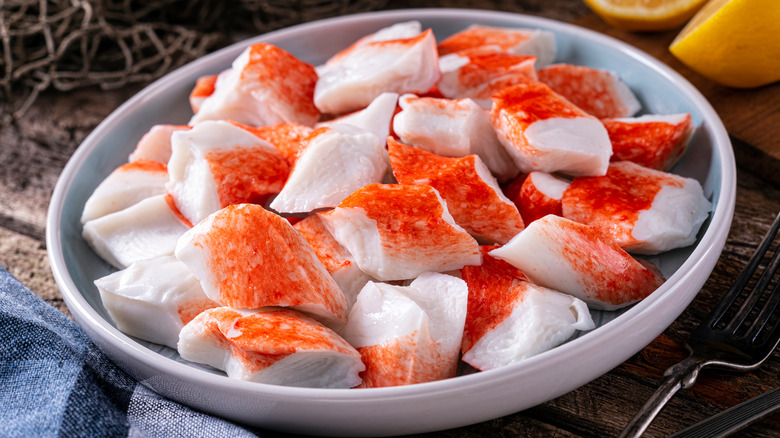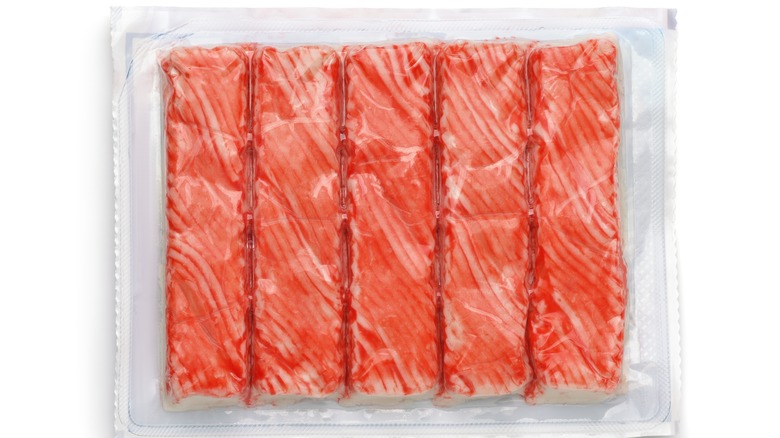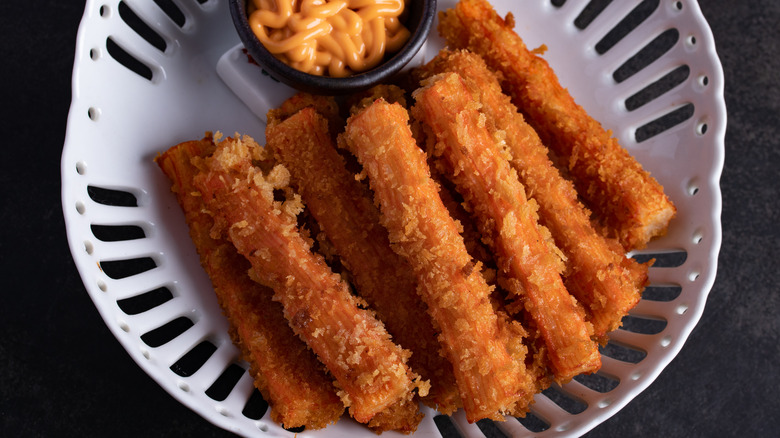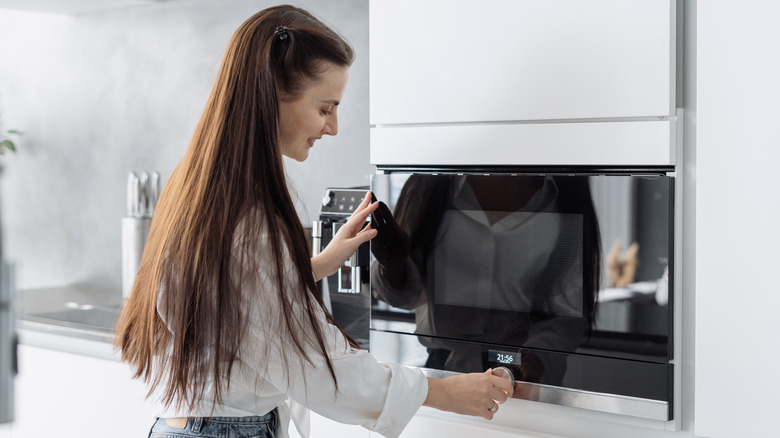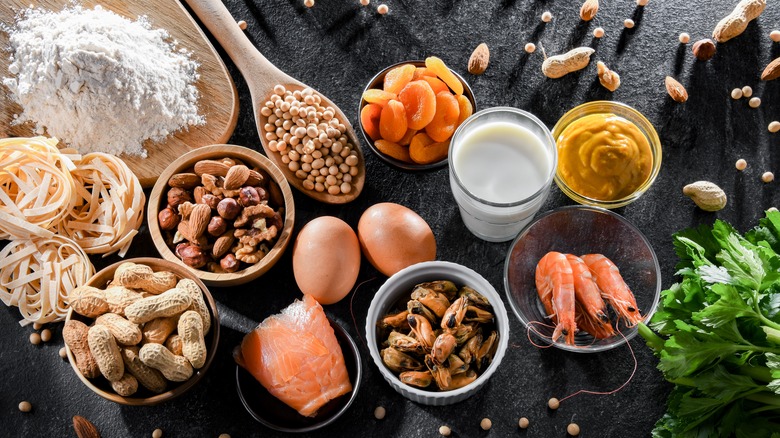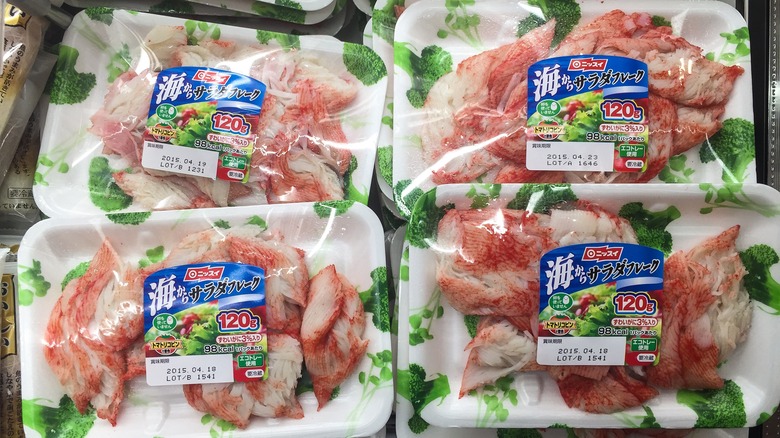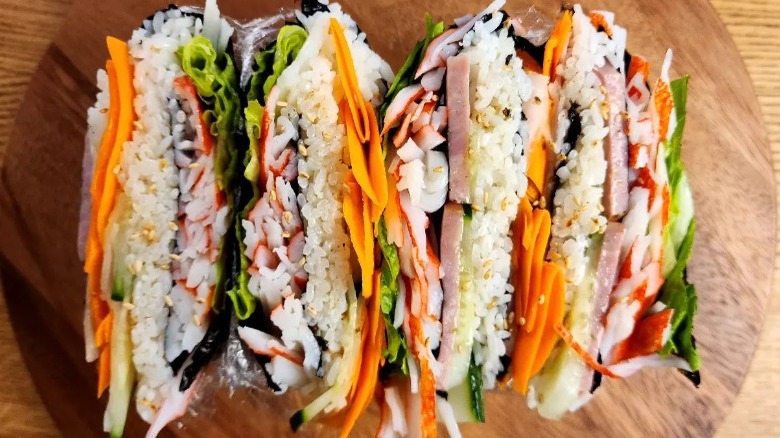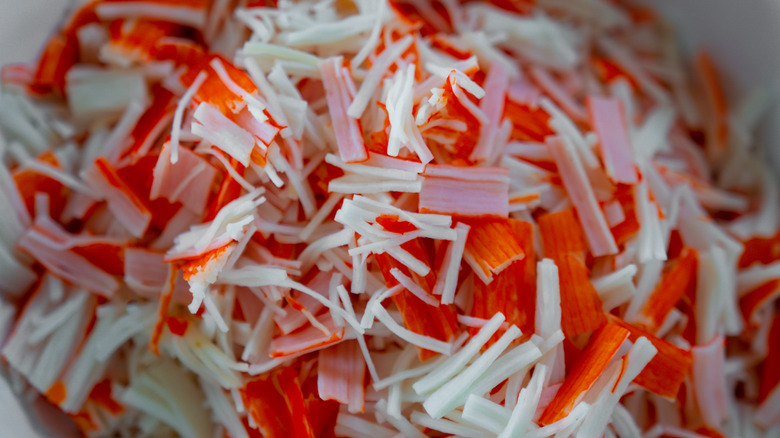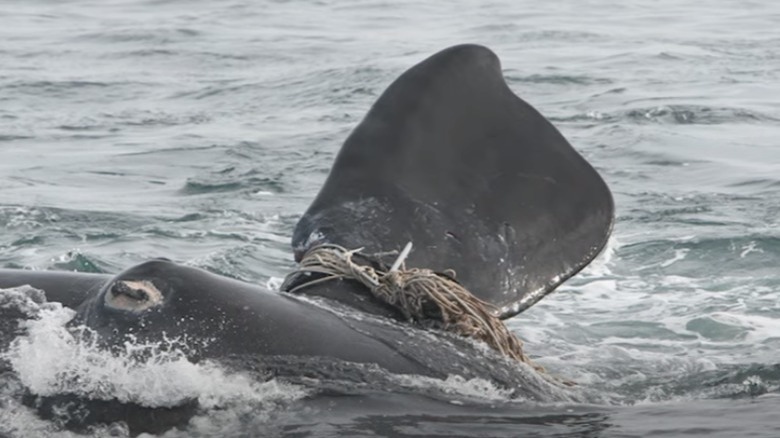Big Mistakes Everyone Makes With Imitation Crab
It's easy to make mistakes with imitation crab. After all, most of us aren't even sure what it's made from since it doesn't usually contain any real crab meat. Since imitation crab meat is made of processed fish meat, it's in limbo land, which makes us unsure of how to cook it or eat it. In fact, we may not even be sure if we need to cook it at all. It's important to demystify this mystery seafood meat a little more so that we're more aware of its nutritional value and how to use it better.
Understanding the ingredients and how packaging companies keep imitation crab fresh and safe can help you make more informed choices on how to use it and when to toss it out. Hopefully, with more knowledge at your fingertips, you'll feel less timid about buying it on a regular basis and using it for a variety of yummy recipes.
Accidentally choosing imitation crab meat over real crab
While some people choose imitation crab meat over real crab meat because it's less expensive, fake crab meat is a food that is much older than we realized. Fake crab meat is made of surimi, has been around for over 1,500 years. Surimi (Japanese for "ground meat") originated in Japan. Some people even refer to surimi as the "hotdog of the sea" because so many ingredients go into making it. Just like hotdogs, surimi has its place in the world. However, it's ultimately very different in flavor, texture, content, and nutrition than real crab meat.
Unless you live in a seaside town, you've probably seen more imitation crab than real crab meat on restaurant menus in everything from seafood salad to crab casserole and sushi. Restaurants don't always label dishes with imitation crab meat as being made with fake crab rather than real crab, which can be a problem if you have whitefish allergies or allergies to some of the other ingredients in the hodge-podge seafood that is surimi.
Thinking you have to cook imitation crab to eat it
While you can cook imitation crab meat, it's not necessary. Imitation crab meat is like a hotdog: All the ingredients are cooked beforehand and molded into the shape you find in the package. The factory vacuum seals the meat into its package, which helps kill most bacteria. While there are a few types of bacteria that can grow without oxygen, most need air to be able to survive. After sealing the meat in its packaging, the manufacturer pasteurizes it, which, according to the FDA, can kill off pathogens that could make you sick, as long as you follow storage instructions and eat it before the expiration date listed on the product.
The FDA provides packaging requirements for imitation crab meat based on which type of pathogens the sealing and pasteurization process should kill. If the packaging indicates that you should keep it frozen, only thaw it in the refrigerator, and only eat it immediately after thawing, it's for safety reasons. So, as long as you read the packaging and follow any consumption or thawing instructions, it should be safe to eat imitation crab meat without cooking it. Of course, if you want to err on the side of caution, you can always cook it anyway.
Assuming it is as nutritious as real crab
Since imitation crab meat is made from pollock, it's easy to assume that it's just as healthy as real crab meat. However, pollock aren't as nutrient-dense as crab meat. And, since surimi is a processed food, it's mixed in with other ingredients that aren't as nutrient-dense either. When you compare it to Alaskan king crab, it has a similar amount of calories, phosphorus, and magnesium, but those are the only similarities.
The vitamins you get from real crabs are significantly different, too. Three ounces of real crab meat provides 408 percent of vitamin B12, 111 percent of copper, 62 percent of selenium, and 55 percent of zinc. Meanwhile, imitation crab only provides 21 percent of vitamin B12, 3 percent of copper, 35 percent of selenium, and 3 percent of zinc you need each day. Surimi doesn't have any vitamin C or folate like real crab meat does, and it has significantly fewer omega-3 fatty acids.
Imitation crab may include other ingredients like carrageenan, MSG, and phosphates which many people try to avoid. So, label reading is important with surimi. However, on the positive side, surimi tends to get its pink color from carmine (from cochineal bugs), paprika, or beet juice, so that is definitely more healthy than red dye No. 40. It tends to have half as much sodium as real crab meat.
Assuming it's okay for a low-carb or ketogenic diet
Since fish is good for a low-carb or ketogenic diet, it's easy to think imitation crab falls into the same category. While the calorie content of both real and fake crab meat are similar, the calories aren't at all equal. Most of the calories in Alaska king crabs (80 percent) are derived from protein rather than carbs (unlike imitation crab meat). Three ounces of surimi has 12.8 grams of carbs, which makes up 63 percent of its calories, whereas real crab contains no carbs at all.
All those carbs in surimi are derived from the filler. Depending on the brand, you're likely to find wheat or corn mixed in with the meat: Potatoes or tapioca starch may be on the ingredient list. These starches help make the surimi easier to freeze and also add to its bulk so the company can sell it for less money. Pseudo-crab meat also tends to contain sugar and sorbitol (a carb-laden sugar alcohol) to give it a sweetness like real crab and help it maintain texture during the freezing and thawing processes.
Not getting the right type for your recipe
Many people may not realize that different varieties of imitation crab meat have different textures and uses. Imitation crab meat is sold in several different varieties; flake-style, in chunks, as crab sticks, or in shredded form. The flake-style or chunk crab meat has a more rubbery texture, and it tends to be sweet. Chunks are good for crab dips and spreads, cold salads, making crab cakes, adding to pasta, and baking in casseroles. You can also add it to soups or use it for the meat in pizzas or quesadillas.
Crab sticks are supposed to remind you of the crab meat you pull out of a crab leg. They are similar to mozzarella string cheese in that you can eat them as sticks or peel them into strings. Crab sticks aren't as dense as chunks, so they're better if you want a juicier piece of meat. You can use them for the same recipes as chunks, plus eat them as an appetizer with a dipping sauce, use them in sushi, or add them to sandwiches. The shredded type is similar to the texture of crab sticks after being pulled apart into strings. It's best to use the shredded type in the recipes where you'd usually use shredded meat, such as in tacos, on top of salads, and in sandwiches. It's also texturally better than chunks for making crab cakes.
Freezing frozen imitation crab meat
When the manufacturer cooks and packages its imitation crab meat, it does so with flavor and texture in mind. If you buy imitation crab meat from the refrigerated section of the store, it should stay refrigerated. And if you buy it from the frozen food aisle, you should keep it frozen. If you don't end up using your refrigerated meat before the expiration date on the package or buy a lot of packages on sale, it can be tempting to freeze it. However, if you do so, you should expect a flavor and textural change.
If you freeze refrigerated imitation crab meat, there are a few things you can do to cover up the flavor and texture change. It may possibly help to allow it to defrost in the fridge overnight rather than just a couple of hours. You also won't notice the difference as much if you eat it in cooked dishes like crab casserole or crab cakes rather than in uncooked dishes like crab salads or sushi. Crab dip is also more forgiving of textural and flavor changes caused by unthawing.
Not knowing how to reheat and cook it
Not knowing how to heat and cook imitation crab meat is a mistake that can ruin the flavor and texture of your dish. The main thing to remember is that you only need to heat it long enough to warm it. If you heat it on the stovetop, you will need a covered pan with a small amount of water or broth. Simply heat it on low heat long enough for the liquid and steam to warm up the meat. Steaming is another great way to reheat imitation crab meat. Three to five minutes should be enough to heat it through without overcooking. Unfortunately, using the microwave to reheat it is more likely to change the texture than other reheating methods. It can help if you lower the power level to 50 percent and microwave it in 20-second segments until warm.
If you're using any other cooking methods like baking or sautéing, you'll want to only cook it as long as it takes to warm everything. So, even with casseroles or hot crab dips, the minimal cooking time should only be as long as it takes to heat all the ingredients. If you need to cook other ingredients longer, like in a stir-fry, you'll want to cook everything else first and add the fake crab meat during the last few minutes. It's even possible to deep-fry crab sticks, but you should only fry them until the outside is golden brown.
Overcooking it
Imitation crab is often rubbery initially, especially if you opt for the chunk variety. Overcooking it can cause it to become more rubbery or even make it become dry and hard. It can also make the meat fall apart rather than stay in a solid chunk. Since everyone's cooking instruments are different, watching the meat while it's cooking can help ensure it doesn't overcook. The goal when you're cooking imitation crab meat is simply to heat it as long as it takes to warm it through.
Since imitation crab meal is already pre-cooked, the packaging should keep it safe from bacteria, you don't have to worry about cooking it for food safety purposes. Instead, reheating and cooking it are about getting it to a temperature that makes your taste buds happy. So, when you're trying to decide how long you need to reheat or cook a dish with fake crab in it, it's all about checking the temperature at regular intervals. Think seconds rather than minutes when microwaving, and check on your pseudo-crab dish that's baking in the oven during the recipe's shortest time suggestion.
Not realizing it may contain allergens
Imitation crab meat is actually made from a multitude of ingredients. According to U.S. law, food packages are supposed to list food ingredients and declare if they contain common allergens. Unfortunately, one of the biggest reasons foods are recalled is because they fail to list allergens or disclose that they are processed in a factory that processes other foods with certain allergies. According to a 2023 study in the Journal of Food Protection, 34 percent of seafood recalls between 2002 and 2022 happened because the company failed to mention an allergen on the package (usually milk or eggs).
Usually, imitation crab meat is made from pollock. Some of the more expensive brands of imitation crab may actually contain real crab. So, people with shellfish allergies should check the label thoroughly to ensure that the ingredient list doesn't include crab or other types of shellfish. Often, the natural flavorings a company uses to enhance the flavor will contain shellfish.
Imitation crab meat also tends to include starch like wheat or corn to help make it firmer. To improve texture and appearance, it includes a protein like eggs or soy. Manufacturers use sugar to imitate crab's natural sweetness and help maintain its texture during freezing. Vegetable or fish oil, salt, stabilizing gums, red food coloring, glutamates, extra flavoring components (like MSG), and preservatives may also be on the ingredient list. So, if you have any type of allergies or food intolerances, it's worthwhile to check the ingredients.
Not realizing that the shelf life may vary
When it comes to imitation crab meat, it's important to notice where you bought it in the store, how it's packaged, and the writing on the label. There's a big difference between refrigerated and frozen, as well as between loose and vacuum-sealed packaging. Different types of imitation crab meat will have different shelf lives.
If your refrigerated surimi comes pasteurized and in a vacuum-sealed package, you can expect it to last for a couple of months or until the "use by" or "sell by" date on the package. If you don't eat it before the package date, you'll want to freeze it. However, once you open the package, the clock starts ticking down like for regular fish, and you should use it within three days. If your refrigerated surimi comes any way other than vacuum-sealed (like on a meat tray), you should treat it like regular fish and use it within three days of getting it or by the "use by" date on the package.
Meanwhile, if you buy it frozen, it should stay good in the freezer for quite a while. However, the quality will start to degrade within 10-12 months. You may notice a "best by" date on a frozen surimi package, but it's a quality guideline rather than a food safety guideline.
Not using it all within three days of opening
When Alaska Pollock polled consumers about their habits surrounding buying imitation crab meat, it turned out that many people don't buy it often because they don't have enough recipes for it. It's not uncommon to buy some for one recipe and then end up having to throw away part of the packet because you can't think of another way to use it within three days. Even people who buy it often wish they had more ideas for using it.
Of course, you can eat surimi plain, but that's not terribly exciting without a dipping sauce. You can use fake crab meat in seafood salads or crab pasta salads. Take inspiration from Asian restaurants and try it in a cheesy casserole, California rolls, kimbap, spring rolls, ramen, or crab rangoon. However, it's also important to think beyond where you've seen it before. You can use it in place of meat in any dish. For example, you could add it as a pizza topping, use it in burritos or tacos, make it into a salad similar to tuna salad for sandwiches, or add it as a salad topping. You could even put it in an omelet for a breakfast meat.
Not recognizing when it has gone bad
One mistake you never want to make with imitation crab is eating it when it has spoiled. Luckily, all you have to do is use your senses to tell if it's gone off. First of all, surimi tends to have a very mild smell when it is fresh. If it has spoiled, it will start to smell fishy. If you noticed that it has become slimy, this is also an indication that it has become overrun by bacteria, and you should toss it in the garbage. If you put it in your mouth and it tastes sour, you'll also want to spit it out without ingesting it because a sour taste is another sign that it has gone bad.
When the pollock in your surimi is alive, the trimethylamine N-oxide (TMAO) helps it maintain the right balance of salt water in its cells. However, after the pollock dies, some chemical changes happen in the fish. Enzymes and bacteria growing on the pollock change the TMAO the live fish needed to survive to another chemical: Trimethylamine (TMA). It's the TMA that smells so fishy, and the fishy smell intensifies with time. Pasteurization and vacuum sealing stop bacterial growth. However, after it is exposed to the air again, the bacteria begins to grow again. So, if you open up a package of new surimi and it already smells fishy in an off-putting way, it has been compromised somewhere along the way and isn't safe to eat.
Not considering the environmental impact
We often make the mistake of not thinking about the effects our seafood habits might have on the environment. Pollock isn't being overfished in the Northwest Atlantic region and in most of Alaska, and it's not clear whether pollock in the Canadian Maritimes, Bogoslof, or the Southeast Gulf of Alaska are being overfished or not. Regardless, pollock fishermen often end up finding overfished or endangered animals tangled in their fishing equipment. Unfortunately, animal fishermen tend to accidentally hurt or kill endangered North Atlantic whales while fishing for pollock includes. It's especially detrimental to other aquatic life when pollock fishermen drag their nets along the seafloor rather than using other fishing methods.
Beyond overfishing or endangering other sealife, the surimi washing process has environmental repercussions. Surimi manufacturers wash the ground pollock repeatedly to improve the fish's smell and appearance. The washing process gives the fish the right texture. Unfortunately, all this washing produces an excess amount of chunky wastewater, which needs to be treated before being pumped back into the ocean.
